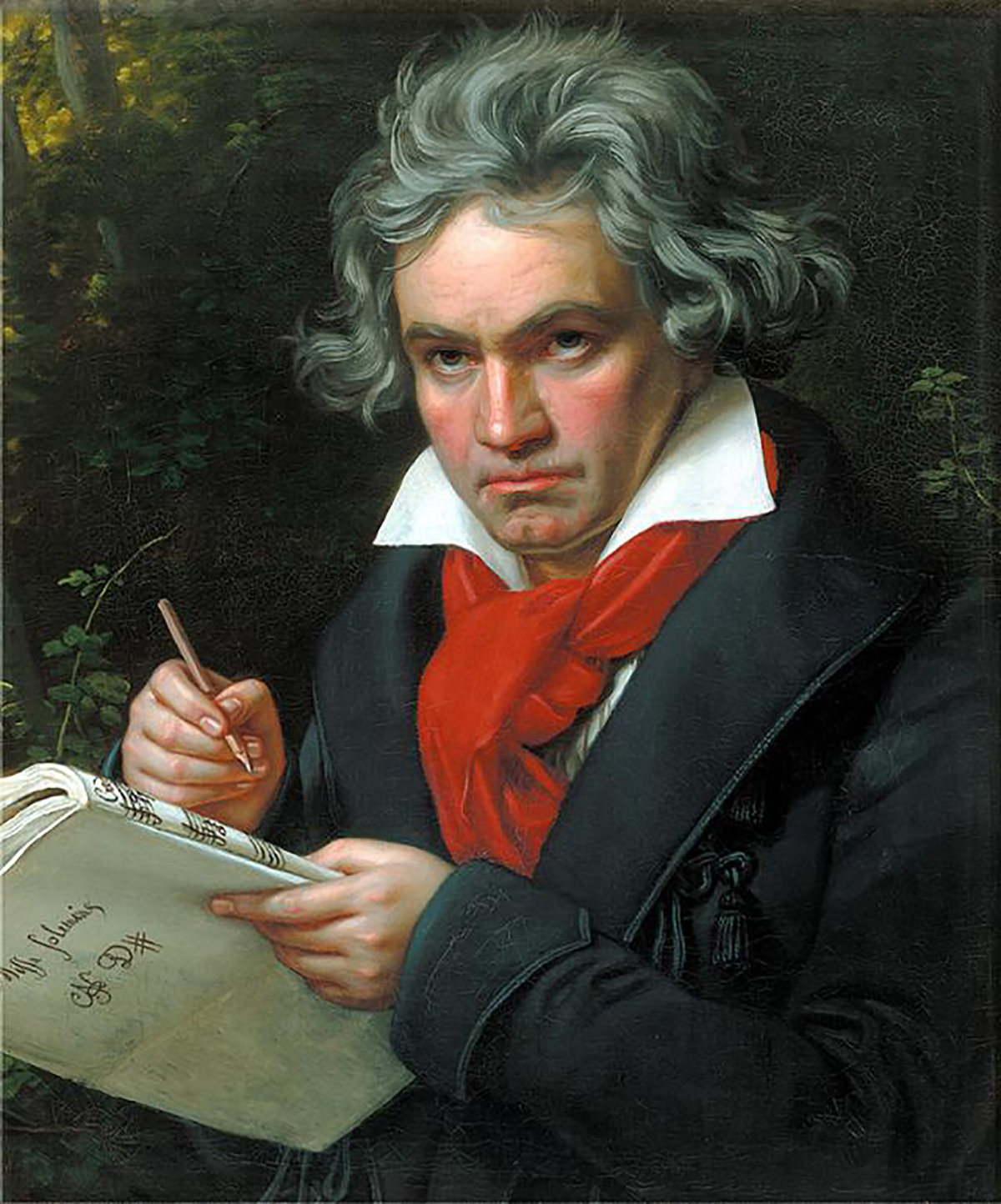독일의 작곡가 루드비히 반 베토벤 (Ludwig van Beethoven, 1770-1827)은 서양음악 작곡가 중 가장 유명한 인물일 것이다. 그리고 우리는 베토벤을 악성(樂聖)이라 부른다. 음악의 성자! 음악가에 있어서 이보다 더한 명예스러운 호칭이 있을까? 하지만 많은 사람들이 상투적으로 베토벤을 악성이라 부를 뿐, 그 이유에 대해서는 잘 알지 못한다. 그리고 널리 알려진 그의 청각장애와 결부시켜 단순히 인간승리의 음악가로 인식하고 있을 뿐이다. 이 또한 틀린 것은 아니다. 하지만 우리가 베토벤을 진정한 악성으로 이해하려면 그의 음악 안에서 이유를 찾아야 한다. 베토벤은 인격적으로 많은 결함이 있었고 도덕적으로도 성자와 같은 삶을 산 것은 아니다. 하지만 그의 음악 안에는 삶과 죽음, 고통과 환희, 감동과 기적, 이 모든 것들이 불멸로 살아 숨 쉬고 있기에 우리는 베토벤을 악성이라 부르고 있는 것이다.
영국 BBC가 2003년 제작한 영화 ‘에로이카 (Eroica)’는 베토벤 교향곡 제3번 '영웅’의 비공개 초연을 다루고 있다. 이 영화는 베토벤 시대의 오케스트라 모습을 그대로 재현하고 있으며, 18세기 귀족과 음악가의 상관관계를 날카롭게 묘사한다. 음악은 지휘자 존 엘리엇 가디너와 그가 이끄는 ‘혁명과 낭만의 오케스트라’ (Orchestre Revolutionnaire et Romantique)가 맡았으며 오케스트라 단원들이 직접 연주자로 출연하여 당시의 악기로 연주를 들려준다. 영화 ‘에로이카’는 많은 장면들이 기억에 남을 정도로 인상적이지만 영화가 끝날 즈음 당시 최고의 작곡가였던 하이든이 영웅 교향곡을 듣고 평가하는 장면은 베토벤에 대한 많은 것을 의미한다.
“그는 이제껏 누구도 시도하지 않았던 것을 하였군…… 그는 작품의 중심에 그 자신을 두었어. 그리고 그는 그의 영혼의 일면을 우리에게 보여주었다네. 이것은 완전히 새로운 것이야. 오늘 이후로 모든 것은 달라질 걸세!”
영화의 배경이 되는 ‘영웅 교향곡’의 비공개 초연은 베토벤의 후원자였던 로브코비츠 공작 저택에서 1803년 12월에 열렸다.는데 하이든의 평가처럼 베토벤의 새로운 교향곡은 충격적인 ‘파격’이었고 청각장애로 고통받고 있던 베토벤의 내면적 음악세계가 드디어 확립되기 시작하는 출발점이기도 하다.

우선 ‘영웅 교향곡’의 파격은 그 규모에서부터 압도적이다. 일반적인 교향곡처럼 4악장의 모습을 갖추고는 있지만 모든 악장이 확장되어 전체 연주 시간이 거의 1시간에 육박한다. 당시 교향곡 전악장의 평균 연주시간이 20~30분 정도인 것을 감안한다면 영웅 교향곡은 그야말로 ‘괴물’ 같은 작품이었다. 그리고 급격한 리듬과 셈여림의 변화, 빈번한 스포르찬도 (특정한 음에 악센트를 넣어 강하게 연주하는 기법)와 조바꿈, 불협화음 등으로 인해 폭력적인 인상을 줄 정도로 강력한 사운드를 만들어 내고 있는데 이런 소리는 당시 청중들뿐만 아니라 귀족 취향의 아름다움만을 추구하던 연주자들에게도 익숙한 것은 아니었다.
‘장송행진곡’이라는 부제가 붙어있는 느린 2악장은 매우 영적이고 감동적인 악장이며, 음악이 인간의 내면 깊숙한 곳까지 파고들 수 있다는 것은 당시 음악을 단순한 유희의 도구로 여겼던 사람들 (특히 귀족들)에게는 엄청난 충격으로 다가왔다. 또한 오케스트라 편성에 호른을 3대나 사용하고 3악장에서 웅장하게 나오는 호른 3중주는 당시로서는 파격적인 시도였고 변주와 푸가를 통한 4악장의 음악적 실험은 훗날 많은 작곡가들에게 영향을 줌과 동시에 악기의 개량에도 큰 영향을 끼치게 된다.
‘영웅 교향곡’의 가장 널리 알려진 에피소드는 나폴레옹에 관한 것이다. 당시 계급사회에 불만을 가지고 있던 베토벤은 나폴레옹이 세상을 바꾸어 평등한 사회로 만들어 줄 수 있는 시민들의 ‘영웅’이 될 것이라 기대했고 그의 교향곡 3번을 나폴레옹에게 헌정할 생각이었다. 하지만 나폴레옹이 황제로 등극했다는 소식을 듣자 "그도 남들과 다르지 않은 속물이었군!" 하고 소리치며 표지에 적혀 있던 나폴레옹의 이름을 칼로 지워버린다. 그리고 ‘한 위대한 인물을 회상하기 위해’라고 제목을 수정하여 발표한다. ‘한 위대한 인물’에 대한 구체적인 설명은 없지만, 제3번 교향곡 속의 진짜 ‘영웅’은 음악가로서 사형선고와 다름없는 청각장애를 딛고 일어나 음악을 통해 세상을 바꾸어 나갔던, 또 음악을 통해 지금 우리에게도 희망의 메시지를 주고 있는 '베토벤' 그 자신일 것이다.
<사진 제공 - 영웅 교향곡 첫 표지>
The Day That Changed Music Forever
German composer Ludwig van Beethoven (1770–1827) is easily the most famous composer of Western music, so much so that he has been christened a musical saint—a holy man of music! There could be no more honorable appellation than this for a musician. However, although many call Beethoven a musical saint, they do not know why. They simply accept his musicality as a human triumph by associating it with his very well-known hearing impairment. While this is not wrong, we must delve into his music to truly understand and appreciate his virtue. Beethoven had many character flaws and did not lead a saintly life in a moral sense. His works, however, capture life and death, pain and joy, and inspiration and miracles, which will prevail eternally in his music, and this is the very reason why Beethoven is a musical saint.
BBC’s Eroica (2003) portrays the private, first performance of Beethoven’s Symphony No. 3 “Heroic Symphony.” The film faithfully recreates the orchestra of Beethoven’s time and sharply describes the relationship between 18th-century aristocrats and musicians. The music in the film was conducted by Sir John Eliot Gardiner and performed by “Orchestre Revolutionnaire et Romantique,” whose members actually appear in the film and play era-appropriate musical instruments. Among the multiple scenes in Eroica that leave lasting impressions, one of the final scenes where Joseph Haydn, the most admired composer at the time, listens to and assesses “Heroic Symphony” offers several implications.
He’s done something no other composer has attempted. He’s placed himself at the center of his work. He gives us a glimpse into his soul… but it is quite, quite new… everything is different from today!
The private debut of “Heroic Symphony,” which serves as the background of the film, was held at the palace of Prince Franz Lobkowitz, a patron of Beethoven, in December 1803. As Haydn had praised, the new symphony was a shocking revelation that also marked the beginning of the establishment of the inner musical realm of the composer, who was in pain and distressed by his deafness.
First, “Heroic Symphony” was a revelation because of its overpowering scale. While it consists of four movements like most other symphonies, all of the movements are extended, and the total performance time nears one hour. Considering the norm of the time for the total performance time to be 20–30 minutes, “Heroic Symphony” was indeed a colossal piece. The rapid rhythm and changes in dynamics, the frequent sforzandos (a method of playing music with prominent stress or accent on certain notes) and modulations, and the dissonant chords create such a powerful sound that it leaves an almost violent impression, which was something unfamiliar to both audiences and performers, who pursued only the elegant tastes of aristocrats.
The second movement, subtitled “Funeral March,” is quite spiritual and inspirational. The fact that a piece of music had the ability to pierce people’s innermost emotions blew minds (especially those of the aristocrats), since music was considered mere amusement back then. Furthermore, placing three horns within the orchestra, who performed majestically during the third movement, was an unprecedented move at the time. Likewise, Beethoven’s musical experiment using a series of variations and the fugue in the fourth movement would influence not only numerous composers in coming centuries but also impact the enhancement of instruments.
The most well-known story behind “Heroic Symphony” involves Napoleon Bonaparte. Beethoven, who harbored dissatisfaction with the hierarchical society of his time, believed Napoleon would change the order of society and bring about equality, becoming a “hero” of the people. With such great expectations, the composer planned to dedicate the third symphony to the French political leader. However, upon hearing the news that Bonaparte had declared himself emperor, Beethoven broke into a rage and exclaimed, "So he is no more than a common mortal!” and crossed out the French emperor’s name on the cover of the musical piece. He revised and released his work under the title “Heroic Symphony, composed to celebrate the memory of a great man.”
Although no details are provided on this “great man,” the actual hero of Symphony No. 3 is Beethoven himself, the composer who overcame deafness, which is like a death sentence to a musician, changed the world, and continues to bring us hope through his music.










